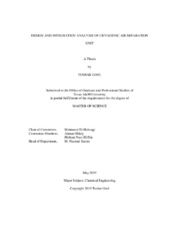| dc.description.abstract | Industrial Gas market is expected to grow to $106 billion from $76 billion by 2022 parallel to the global energy and chemical production sector growth. Air separation is one of the major technologies utilized within this industry to supply Nitrogen, Oxygen and Inert gasses for various industrial applications. Cryogenic separation has emerged as a technology of choice for high capacity and high purity units, but it is also known for its high energy intensive characteristic. Cryogenic air separation units (CASU) utilize electricity to produce refrigeration for liquefaction and separation of air components, operating near temperatures as low as 78 K and consuming around 200kWh/ton oxygen product. Even 1% increase in efficiency can result in millions of dollars of energy savings annually.
CASU technology inherits tight heat integration with approach temperatures of up to ~1oC in the heat exchangers due to refrigeration at very low temperatures. This work is intended to systematically study and analyze the dependence of energy usage of this technology on process design, utilize the insights of this analysis to develop a framework for design improvement and operation of the plant, and develop heat integration map of the unit operations. Benchmarking of this heat integration is performed using pinch analysis. As part of the work, sensitivity analysis of the complex thermally coupled sequential distillation system is also presented. Well established benchmarking and targeting techniques pioneered by Dr. El- Halwagi are used to investigate the ‘big picture’ without getting into heat exchanger network details. The novel insight presented by this research is the dependence of enthalpy flow into the separation section on the product recoveries. A unique way to assess heat flow by dissecting the process into smaller control volume helps in overall enthalpy balance which helps in estimating important process parameters. This helps in reducing the handles available for process modification. Finally, a case study is presented where the implementation of control volume approach and resultant process improvement is demonstrated. | en |


